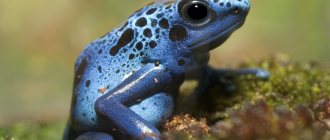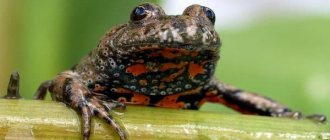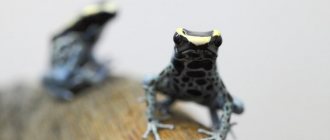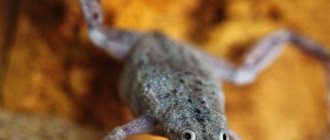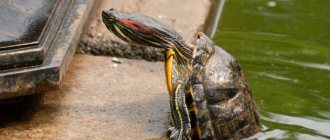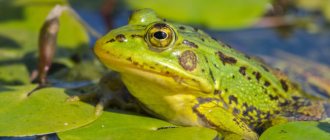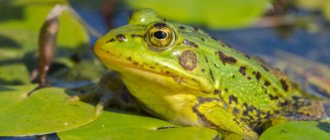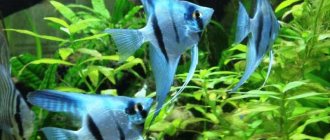The ancient ancestors of frogs appeared on Earth approximately 290 million years ago, and nature decreed that the most beautiful representatives of tailless amphibians are also the most dangerous. Tree frogs, frogs and toads mostly use toxic poisons for defense, and rarely attack first. Our short review presents the most poisonous frogs that have chosen the tropical forests, swamps and reservoirs of our amazing planet. And you can see the most poisonous insects in the article on our website TopCafe.su.
Here are the most poisonous frogs in the world:
13
Phyllomedusa bicolor
This large frog, often called the monkey frog, is very curious. Although its venom is not as dangerous as that of some other representatives of the frog world, most of us are unlikely to want to try its effects: the venom can cause unpleasant hallucinations or stomach problems. We say "most of us" because some tribes on the banks of the Amazon do deliberately use their poison to induce hallucinations.
Spotted dart frog
The spotted poison dart frog is amazingly beautiful. Moreover, beauty is due to multi-colored skin.
It is important to note that the skin of the spotted poison dart frog is poisonous. It is interesting to note that the poison has a special effect on parrots. Amazon tribes noticed that the color of parrot feathers changes under the influence of the venom of the spotted dart frog.
Ranitomeya reticulatus
Native to Peru, this frog has a mild venom that can cause health problems in humans and can kill some animals. Like other poisonous frogs, these beautiful little creatures require special food to produce their poison. In this case, the “raw material” of poison for them is a poisonous ant. The frog stores poison in the skin glands and releases it as needed. Most often this happens in case of danger, when some predator is about to eat the frog.
Poison tree frog / Trachycephalus venulosus
A rather large frog, growing up to 9 cm in length, comes from Brazil, which is why it is also called the Brazilian tree frog.
It has an unusual coloration, consisting of spots of various sizes, forming a concentric pattern throughout the body. A distinctive feature is also the small red spots on the back and neck of the amphibian.
They prefer to live most of their lives in trees, and during breeding periods they move closer to bodies of water. Females lay eggs in ponds and lakes, which can dry out, but the offspring still survive early.
By the way, if you haven’t looked at our article about the most unusual species of frogs, be sure to do so!
6
Dendrobates azureus
This frog is really very cute, as can be seen from the photo. However, its beautiful and bright color does not bode well: its poison is enough to kill even the largest natural predator; there are cases where even people died from this poison. However, some brave people keep these creatures at home as pets. How is this possible, you ask? Fortunately, in captivity, frogs lose their poisonous properties, because they do not receive special food to produce poison, and they don’t need it, since no one will harm them in the aquarium. The frog retains its wonderful appearance, but loses its poison. This applies to all frogs on our list.
How do they reproduce?
According to the type of behavior, frogs are divided into two types: with seasonal or with spontaneous reproduction. In the first case, the mating season occurs annually, and it begins in the same season. In the second case, the signal for reproduction is the onset of certain favorable conditions.
Frogs are characterized by external fertilization. During spawning, the male is on the female's back and covers the emerging eggs with sperm. Caviar has an oxygen-permeable shell. The duration of embryo maturation depends on the type and environmental conditions.
Stages of development
The larvae that hatch from the eggs are called tadpoles. They differ significantly from adult individuals and are adapted to life in water: breathing occurs with the help of gills, the body is elongated and has a fish-like tail, and the eyes are devoid of eyelids. The cubs have no teeth and eat plant matter.
After completion of the tadpole stage, which lasts from one to four months, metamorphosis occurs. This stage of development is characterized by a number of changes, during which the frogs acquire the features of adults. After metamorphosis is completed, they move into the habitat characteristic of their species.
Stages of frog development - video
Phyllobates lugubris
The charming leaf climber is the least poisonous of its genus, although it still makes its victims bitterly regret that they tried to attack it. He is called "charming frog" only because of his appearance. If you want to find representatives of this species in the wild, you should go to Central America. It is unlikely that you will have to look for it for a long time, since such poisonous creatures are usually not going to hide from someone.
golden frog
The golden frog, also called the dire frog , lives on the Colombian coasts. These representatives of amphibians love wet and hot weather. It is important to note that golden frogs often live in areas where air humidity reaches 90 percent. Moreover, in the forest these amphibians can only be found in groups of 5–6 individuals.
If you look at the terrible leaf climber, you might be surprised by this name. Amphibians are distinguished by their harmless color and small size. In addition, the behavior of frogs is surprising in their calmness. However, the terrible leaf climber still turns out to be a dangerous reptile. History has even recorded a case of death, and the death of a person occurred instantly.
Why is the leaf climber so dangerous? The skin of this species of frog is covered with special alkaloids that produce a strong poison called batrachotoxin. The steroid alkaloid can block the functioning of vital organs, paralyze the nervous system, develop severe arrhythmia and heart failure. It is almost impossible to survive after this.
Ranitomeya variabilis
These beautiful creatures live in the tropical forests of Ecuador and Peru and are one of the most poisonous members of the Ranitomeya
. The poison of one frog can be enough to kill 5 people! Although the frog looks very cute, it should not be touched under any circumstances. Even if you are lucky enough to visit the forests of Ecuador or Peru, you should not be afraid to encounter a frog. She will never attack first.
Chiriquita toad
In Panama and Costa Rica you can find one of the most poisonous toads, which has a bright color and does not grow more than 5 cm. Note that males are usually smaller and reach a length of only 3 cm.
When poison gets on the skin, the channels of nerve endings are blocked, and the person experiences a loss of coordination of movement, the person begins to have convulsions, and the sad result of all this can be complete paralysis.
Unfortunately, an antidote has not yet been invented, but it is necessary to carry out general detoxification in time, and then irreparable consequences for the health of the human body can be avoided.
7
Epipedobates tricolor
These frogs are very small, but are one of the most deadly amphibians. They can kill not only large animals, but also humans, so no one would think of playing with them. Frogs are endangered, so they can rarely be found even in their homeland - in the forests of Ecuador. To save these frogs and increase their numbers, researchers are trying to breed them in captivity. Preserving them is also important from a medical point of view: the poison of these frogs is 200 times stronger than morphine and is an excellent pain reliever.
Striped leaf climber
In the poison dart frog family, there is a genus with a similar name – leaf frogs. The striped leaf climber is predominantly black, but has a bright stripe on its back. In some individuals it is yellow. A wide stripe of bright orange, red or gold runs along the frog's face and all the way to the base of the thigh. There is also a white line on their bodies that extends beyond the shoulder.
The feet of striped leaf climbers are blue-green due to many small specks. Also on the underside, light spots of blue and green colors create a marble pattern. Striped leaf climbers are distinguished by their very small size. Adult males grow to a maximum of 26 mm, while females can be 31 mm.
You can meet such frogs in a bay of the Pacific Ocean called Golfo Dulce, or in the humid forests of Costa Rica. Striped leaf climbers live in high terrain, up to 500 m above sea level. They hide between tree roots and in rocky crevices, leading a predominantly terrestrial lifestyle.
Phyllobates terribilis
This extremely poisonous frog lives in Colombia. Despite their eye-catching appearance, these creatures are not the type to play with: their bright colors warn of danger. In fact, these frogs are so poisonous that a person can die just by touching them, hence the name. Dire leaf climbers do not use venom to kill their prey, but only to protect themselves from predators. Therefore, if you see frogs in the forest, but do not try to touch them, they will not cause you any harm.
Summarize
So we met some beautiful, but very dangerous frogs. Unfortunately, reports about people being poisoned by frogs quite often appear on news feeds. In nature, everything is thought out to the smallest detail, and the unusual color and appearance of amphibians acts as a kind of warning that this is a dangerous and poisonous creature.
The editors of TopCafe wish you to meet these amazing animals only on the screen or in a terrarium. We look forward to your comments about the most poisonous frogs on the planet.
Editor's note: This article has been updated since its original publication in November 2021.
Application
The discoverers of batrachotoxin and its advanced users, of course, are the indigenous people of South America. It was they who improved the hunting process using poisonous arrows, thereby making it faster and less dangerous. Not counting, of course, the risk of wounding the hunter himself with this arrow.
Outside the Amazon jungle, the use of batrachotoxin is limited to scientific research. With its help, the mechanism of action of various substances on the permeability of sodium channels in cell membranes is studied.
The use of batrachotoxin is especially important for pharmacological studies. A tenth of the drugs used in medicine act on ion channels. These drugs include painkillers, antiarrhythmics, and local anesthetics. To create new, more advanced drugs, a complete understanding of the structure and mechanism of action of cell membrane channels is required. Scientific research constantly adds new data to existing information. Batrachotoxin is a valuable organic substance for studying the cell membrane and its permeability.
Behavior
Blue dart frogs in the wild coexist on land in mixed groups of up to 60 individuals. They lead a daily lifestyle. They walk almost all day, alternately moving their paws, and less often jump on the forest floor in search of food.
Dart frogs lead an active daily lifestyle
Males protect the areas occupied by their “harem”. They use sounds to inform opponents about this. And if their territory is encroached upon, they furiously try to push the invader out of it.
Their fights are similar to freestyle wrestling. The male, who is defeated, bows his head to the ground. It happens that fights end in the death of an opponent due to broken limbs.
Links[edit]
- Portal of amphibians and reptiles
- Animal portal
- ^ ab Philippe Gaucher; Ross McCulloch (2010). "Dendrobates tinctorius". IUCN Red List of Threatened Species
.
2010
: e.T55204A11265402. DOI: 10.2305/IUCN.UK.2010-2.RLTS.T55204A11265402.en. - Wollenberg, Katharina S.; Veith, Michael; Noonan, Brice P.; Letters, Stefan (2006). Quattro, J. M. (ed.). "Polymorphism versus species richness—taxonomy of large dendrobats from the Eastern Guiana Shield (Amphibia: Dendrobatidae)." Kopeya
.
6
(4): 623. DOI: 10.1643/0045-8511 (2006) 6 [623:PVSROL]2.0.CO; 2.
Description
The blue dart frog (lat. Dendrobates tinctorius azureus) is a tailless amphibian of the dart frog family (Dendrobatidae). The subspecies are currently not studied.
The body length of the blue dart frog is 3.5-4.5 cm. Males are shorter than females by about 0.5 cm. Weight is 3-6 grams.
The size of frogs in natural conditions is 3.5-4.5 cm
Life expectancy in the wild is 7 years, in a terrarium – 10-12 years.
Terrarists often call them azureus, as well as azure poison dart frogs.
The species is listed in the International Red Book.
Diseases
Dart frogs are rather gentle creatures, and therefore, when kept in terrariums, they are often susceptible to diseases such as:
- dropsy,
- intestinal obstruction,
- pneumonia;
- blood poisoning;
- infectious pathologies;
- mycosis;
- rotting of bone and cartilage tissue;
- salmonellosis.
Many of these diseases are difficult to treat and therefore deadly. Experts and veterinarians recommend strictly following the regimen and diet of azure dart frogs, as well as the basic conditions for keeping pets, non-compliance with which often causes diseases.
Be sure to contact your veterinarian if you notice any symptoms of the disease.
If alarming symptoms are detected in an amphibian, you should immediately contact a veterinarian
What is batrachotoxin
This is a natural organic compound from the group of steroidal alkaloids. Batrachotoxin is a non-protein poison, one of the most powerful zoological toxins. The substance is a derivative of the steroid pregnin. It is an ether with a crystalline structure, insoluble in water.
The chemical formula of batrachotoxin is C31H42N2O6. Its molecular weight is 538.68 g/mol, density is 1.304 g/cm3. The compound decomposes in alkaline media, but is capable of dissolution in alcohols.
The study of batrachotoxin began in the sixties of the last century. A scientific expedition collected about a thousand tree frogs in Colombia. Extraction of the poisonous secretion was carried out immediately after catching the animals - this was done for insurance, since if the amphibians died during transportation, the possibility of obtaining poison would be lost. In 1962–1963, American scientists Daly and Witkop isolated pure poison from the secretion of the skin glands of poison dart frogs. It turned out to be combined and consisted of four toxins:
- pure batrachotoxin;
- isobatrachotoxin;
- pseudobatrachotoxin;
- batrachotoxin A.
Only after a comprehensive study of the structure and properties of the components of the poison, in the late nineties of the 20th century, the synthesis of this organic compound was carried out.
Venom of tailless amphibians
In general, the venom of frogs and toads is primarily a protein, which includes highly active compounds, enzymes, catalysts, etc. It contains chemicals that act on the nervous system, mainly the peripheral one, as well as proteins that cause the destruction of erythrocytes - red blood cells. The poison contains substances that selectively act on the heart.
Interestingly, these toxins have a special biological significance for the amphibians themselves. Cocoa, which has a bright, provocative color that scares away predators, has an exceptionally strong poison in its effect. Frogs, which are quite closely related to cocoa, but have a calm, inconspicuous coloration, generally lack a poisonous secretion.
The presence, or, conversely, absence of certain substances in the skin of frogs depends on the location and conditions of their habitat. For example, amphibians that spend a lot of time on land have chemical components that can protect them in a terrestrial environment, unlike animals that prefer a longer aquatic lifestyle. It is interesting that the suprascapular glands of toads contain components in the venom that are cardiotoxic, i.e. acting primarily on the heart. Apparently, this feature of their poison is due to their terrestrial lifestyle and serves as protection against attacks by predators. Even snakes will not eat a brightly colored toad, and if they grab it, they will try to throw it back. This is despite the fact that many snakes have their own venom glands and have a certain natural immunity to venom.
The poison of tiny leaf climbers is sometimes dangerous for the frogs themselves. It is so strong in its effect that, if it accidentally gets into a scratch on their skin, it can kill the frog itself. Apparently, the frogs that produce it are not exposed to the poison under normal living conditions. This is explained by the fact that the cells producing the poison are well isolated from other tissues and the toxin cannot spread throughout the body.
There are practically no antidotes against leaf climber poison. The skin of an adult frog, less than 50 mm long, contains a very toxic substance, batrachotoxin, first isolated from the venom of the Colombian frog. Batrachotoxin is a chemical found in the skin venom of five species of frogs native to southern Central America and northwestern South America. Currently, scientists have been able to artificially obtain this substance in the laboratory, and its toxic properties are not inferior to natural ones.
